Vegan Pierogi Ruski - soft traditional dumplings filled with a mixture of mashed potato, sautéed onion, and dairy free ricotta cheese. A traditional dish made plant based that is super comforting and wholesome!
Jump to:
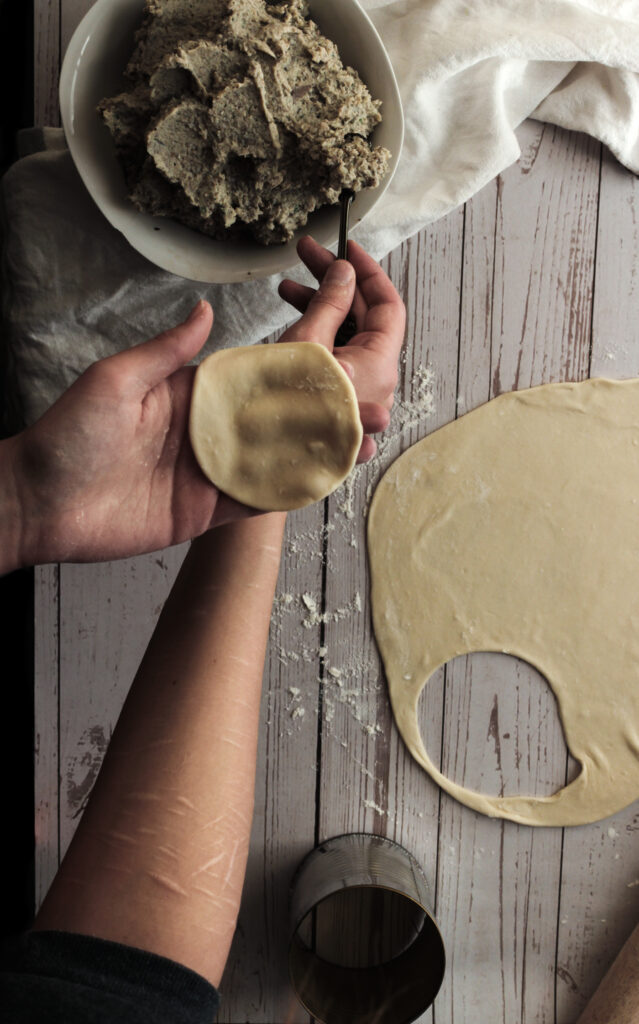
💡 The recipe in a nutshell
- Vegan (Eggless and dairy free)
- Authentic Polish recipe turned plant based
- Comfort food
- Made from scratch
🥟 What is pierogi?
Simply put it is a filled dumpling. Pierogi are associated with the cuisines of Eastern and Southeastern Europe. Most people think of Poland when they hear the word Pierogi.
Popular pierogi fillings include savory and sweet, such as potatoes, cheese, meat, sauerkraut or fruits. Another admired filling combo is mashed potatoes, polish white cheese and stir fried onion. This version is Ruskie Pierogi. The white cheese here is referring to a special prepared sweetened Polish dairy curd cheese. However for this veganized version we are using vegan ricotta cheese instead.
🧑🍳 How to make
To make pierogi you prepare a very simple noodle dough. Which you then thinly roll out and cut into circles. Working with one dough circle at a time you add around a teaspoon of your prepared filling into the center of the circle cutout. You fold the dough over to form a half-moon shape and then pinch the edges together. You continue to until no dough remains.
After filling the dough and forming the dumplings, you boil them in water with a bit of oil. Once cooked you can enjoy your homemade pierogi right away, or pan-fry them with some vegan butter (or oil) in a pan until crisp.
🇵🇱 History and origin
Before we jump right into the recipe, let's learn a little bit more about the history of pierogi! They are in fact Poland’s pride and joy, and probably the most recognizable Polish dish around the globe nowadays.
Many polish cookbooks from the 17th century describe pierogi as a staple of the Polish diet. Even more fascinating, each traditional holiday had its own special kind of pierogi! However the little dumplings are not only popular in Poland. Other European countries such as Slovakia, Romania and Ukraine have their own version of pierogi as well. You could say these kind of dumplings are a Central and Eastern European staple.
Overall it’s difficult to pin down the real origin of pierogi, but some people think they came to Poland from Russia. Others think they were invented by the Chinese, brought to Italy by Marco Polo until arriving in Poland. And some believe they were born in Turkey and brought to Europe from there.
Wherever they really come from: They are one of the most famous national foods of Poland and crazy delicious. They are a must-try for anyone who hasn't had them yet!
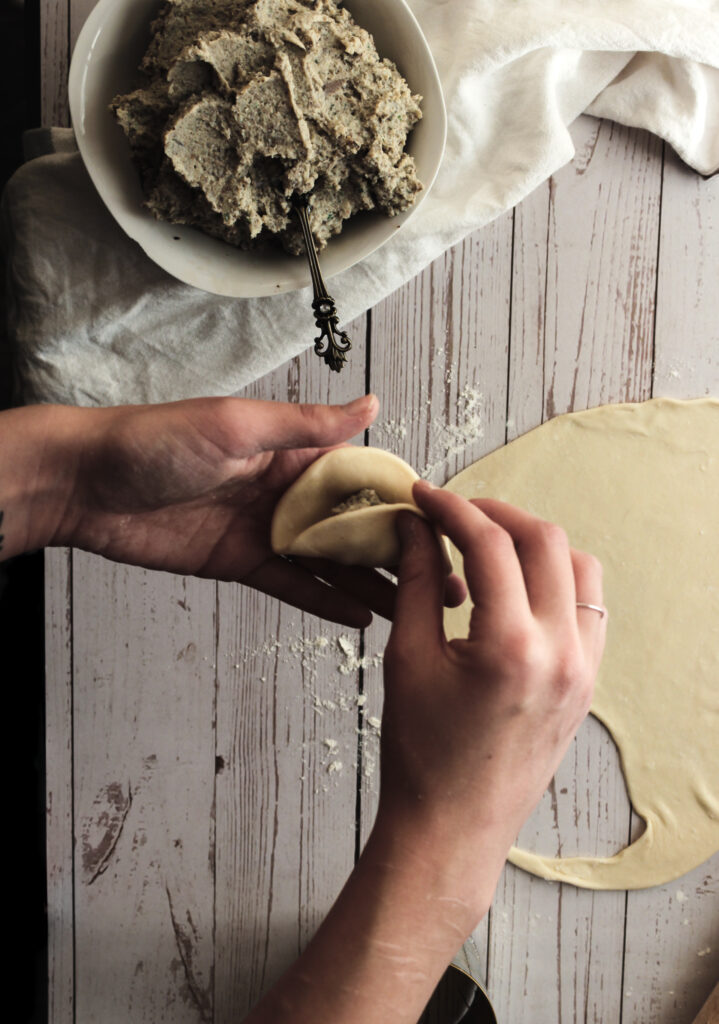
The story behind this recipe
During High School in Germany I took part in an exchange program. A bunch of my schoolmates and me travelled to Poland where we would meet and live with an exchange student, and vise versa.
My exchange partner was a girl whose name is Karolina. We got along so well that we became great friends. We kept in contact and visited each other many times after the exchange program. She even invited me to her wedding in Poland a couple years back (which was an incredible experience). Anyways, Karolina took me to her grandma's place several times. Her grandma not only fed us well with her traditional pierogi each time, but she also actually shared her recipe with me and taught us how to make them!
Hence, this recipe is based on babcia's recipe. The traditional dumpling dough is vegan all along, so I only had to veganize the filling that traditionally comes with a Polish dairy based white cheese. I hope you enjoy my veganized version as much as I do!
⚪️ Storage
You can keep your unboiled and boiled pierogi in the fridge ready to go for two to three days. To store prepped (but not cooked) pierogi, store in one layer in the fridge for two days. If you need to layer them add a sheet of vegan wax paper or parchment in an airtight container! If you want to keep them longer freeze them.
❄️ How to freeze
You most certainly can freeze your pierogi. However I recommend to blanch them in water first. Since they’re likely to crack when frozen raw. To freeze pierogi wait for them to cool completely. Next, place them in a freezer for around 2 hours. After that move into a freezer-friendly bag. Remember to label and date the bag. They can be stored for up to 3 months in the freezer. They can be cooked, or fried, straight from the freezer.
📖 Recipe
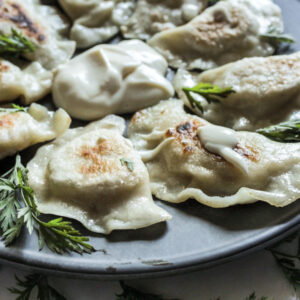
Vegan Pierogi Ruskie - Polish Dumplings
Equipment
- rolling pin; kitchen towel; two bowls; cooking pot; a round cookie cutter, ravioli stamp cutter or an up-cycled tin can with a radius of Ø 3inches / 7.5cm
Ingredients
Pierogi dough
- 250 grams all purpose flour
- ½ tablespoons oil
- 150 mililiters warm water
Pierogi ruskie filling
- 200 grams vegan ricotta cheese* for ricotta recipe check recipe notes
- 3 medium cooked potatoes use a potato that is high in starch, like russet or yukon gold
- 2 tablespoons plant milk (eg allmond or oat)
- 1 medium yellow onion chopped
- salt and pepper to taste
Garnish ideas
- vegan yogurt, or vegan sour cream
- fresh herbs or carrot greens chopped
Instructions
Preparing the dough:
- Pour flour into a bowl in a rectangular shape and make a little whole in it, so it looks like a flour volcano. Pour oil into the "volcano" hole. Put your index finger into the hole, making swirls until the flour starts slowly mixing with the oil. It will start to give you these flour-oil chunks.
- Add half of your warm water and mix everything together quickly. Once the first amount of water is kneaded into the flour, add the rest of the water. Once a dough ball has formed, transfer to a floured pastry board to knead. Poles traditionally use a so called "Stolnica" as their pastry board, but a clean countertop works too. Gently knead until soft and elastic, the dough ends up being almost like a Play-Doh-like consistency: firm and springy, but not too dense. Avoid for too long, or the dough will become tough.
- Transfer into a bowl and cover, best with a damp kitchen towel, so it doesn't dry out. Set aside for at least 30 minutes, or until you're ready to prepare the dumplings.
Preparing the filling:
- If not using store bought vegan ricotta, make and prepare your vegan ricotta cheese. Peel and quarter potatoes. Boil potatoes until soft and let cool down. Chop onion into very small pieces and sauté in a frying pan until glassy. Set aside when done.
- Once potatoes are cooled mash them with plant milk in the pot with a potato masher. Once your potatoes are mashed, add sautéed onion and mix together. Then fold in your vegan ricotta. Salt and pepper to taste, if needed.
Rolling, stuffing and shaping:
- Spread out parchment paper and flour it thoroughly - this is where you will place your pierogi once they are filled and formed. Set a damp towel aside and gather your tools: rolling pin and round cutter. Flour your pastry board, or clean countertop. Divide pierogi dough ball into four. Take one fourth and roll out thin onto your floured work surface. It should be around 2mm thick (which is around 1/12 inch). Once rolled out stamp out circles.
- Take a circle in your hand. Spoon 1 - 1 ½ teaspoons of the filling into the middle of the dough circle. Stretch the dough around the filling, basically folding it in half. Don't get the filling up to the edges! Gently push the filling in, because otherwise the pierogi could open up once you boil them. Bring the dough together and pinch the edges really tight together. Always keep a little flour on your fingertips, to prevent the dough from sticking onto your fingers.
- Place the filled pierogi on your parchment paper in one row. Don't stack them, or they may merge together. Cover with the damp kitchen towel until ready to cook. Gather scraps, re-roll and fill. Repeat until no dough is remaining.
Cooking the pierogi:
- Add water to a big pot, together with 1 tablespoon of oil and salt. Bring to a boil, then add your raw pierogi. Make sure you don't "overcrowd" the pot. This depends a bit on the size of pot you are using, but they should have space to sink and swim up to the surface. Boil pierogi at medium high heat: the water should still bubble, but not aggressively. Once the pierogi swim up and reach the surface of the water, let them boil for another 1 or 2 minutes. Remove pierogi with a slotted spoon. If you want to make sure they're done take one out to taste test. Just be careful since they will be hot! Gently remove boiled pierogi from pot. Don't squeeze or pop them. Place on a slightly buttered platter. Continue until all pierogi are boiled.
- Serve as is, or fry pierogi until golden brown in a pan. If you decide to fry your pierogi add plenty of vegan butter (or oil). Once hot, fry on both sides until crisp.
- Enjoy with dollops of vegan yogurt or sour cream, and garnish with fresh herbs or greens if wished. Smacznego!
Notes
The provided nutritional information is an estimate. Accuracy is not guaranteed.
PS: Don't forget to rate this recipe and leave a comment on your experience - this helps improving my recipes and serve you with best instructions, tips and substitution ideas. Plus, I love hearing about your takes on my recipes! Tag me on Instagram @thesimplesprinkle to show me your pictures.

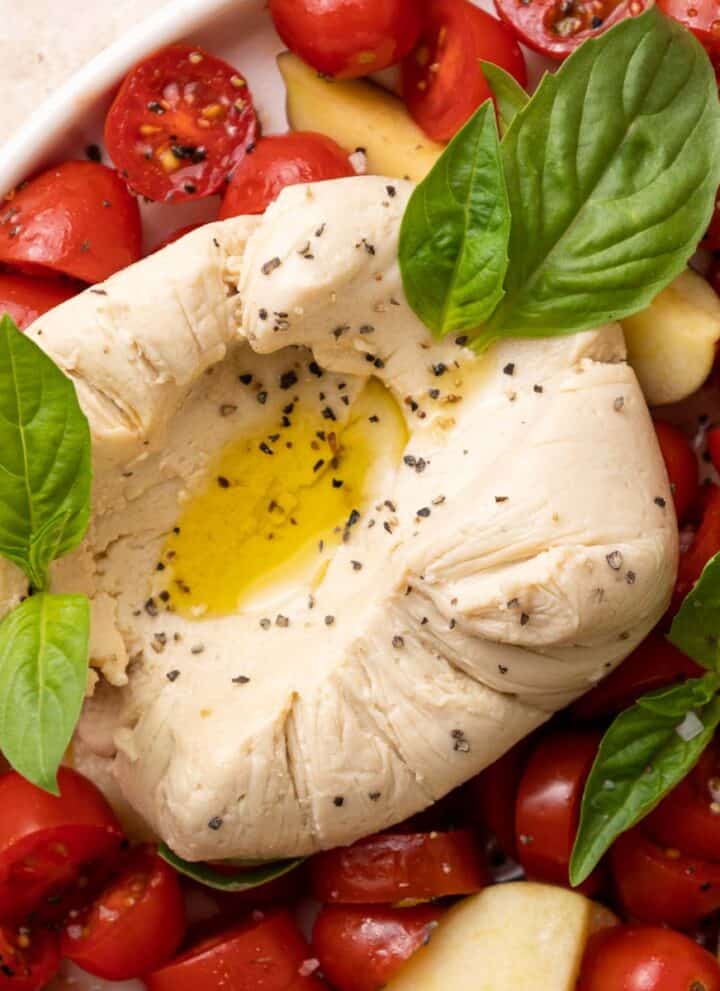


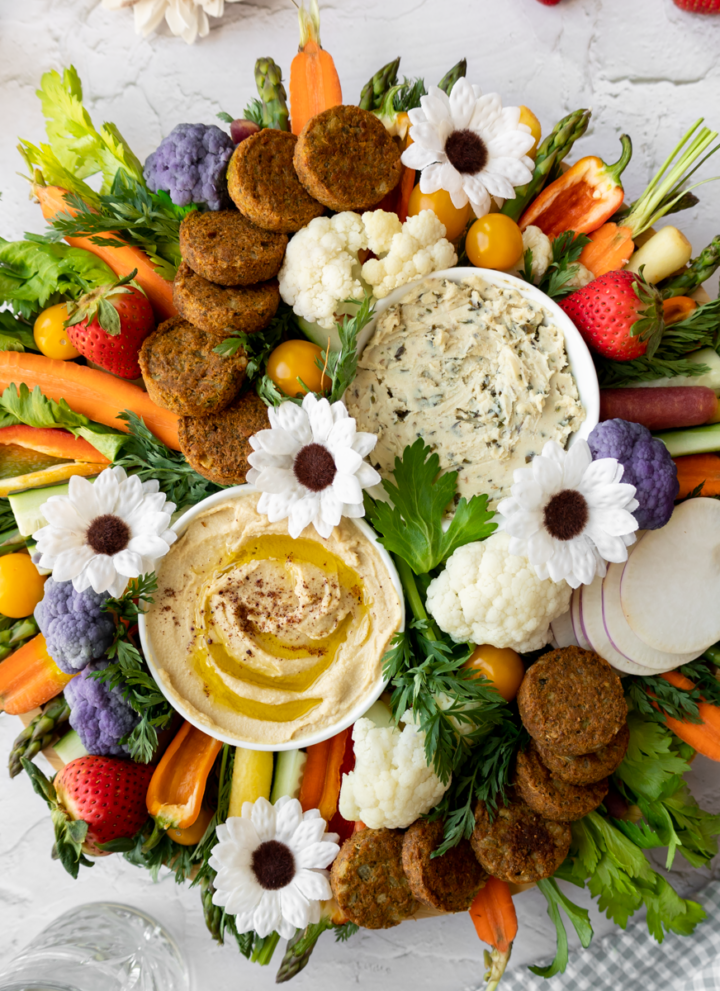
How about sauerkraut ones!
What a great idea! Sounds delicious!